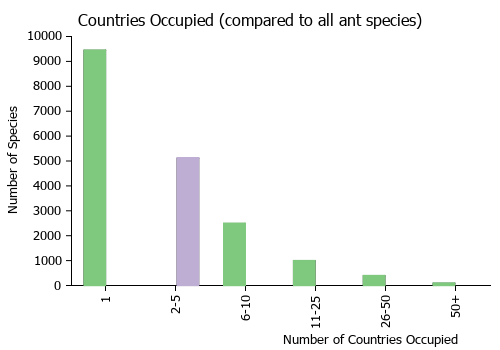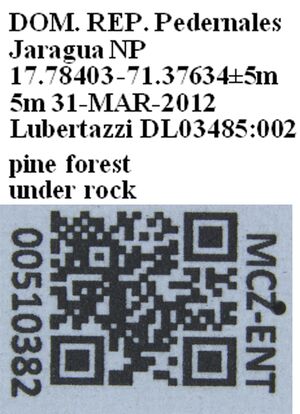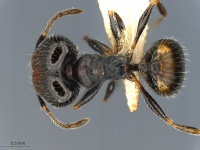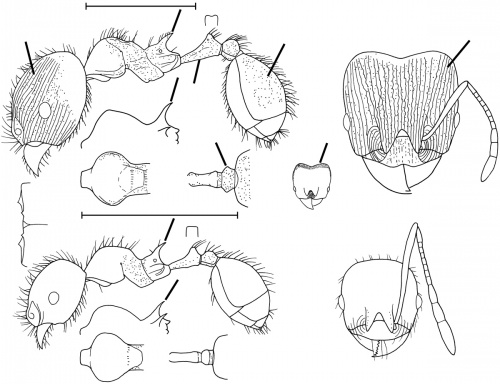Pheidole drepanon
| Pheidole drepanon | |
|---|---|

| |
| Scientific classification | |
| Kingdom: | Animalia |
| Phylum: | Arthropoda |
| Class: | Insecta |
| Order: | Hymenoptera |
| Family: | Formicidae |
| Subfamily: | Myrmicinae |
| Tribe: | Attini |
| Genus: | Pheidole |
| Species: | P. drepanon |
| Binomial name | |
| Pheidole drepanon Wilson, 2003 | |
The type colony was collected in tropical evergreen forest. (Wilson 2003)
Identification
See the description in the nomenclature section.
Keys including this Species
Distribution
Pheidole drepanon is a Dominican Republic endemic; it is known from close to a dozen collections in Pedernales and Monte Cristo Provinces. P. drepanon may also occur in Haiti, especially since the type locality is close to the border.
Latitudinal Distribution Pattern
Latitudinal Range: 19.8925° to 17.78099°.
| North Temperate |
North Subtropical |
Tropical | South Subtropical |
South Temperate |
- Source: AntMaps
Distribution based on Regional Taxon Lists
Neotropical Region: Dominican Republic (type locality), Greater Antilles.
Distribution based on AntMaps
Distribution based on AntWeb specimens
Check data from AntWeb
Countries Occupied
| Number of countries occupied by this species based on AntWiki Regional Taxon Lists. In general, fewer countries occupied indicates a narrower range, while more countries indicates a more widespread species. |

|
Estimated Abundance
| Relative abundance based on number of AntMaps records per species (this species within the purple bar). Fewer records (to the left) indicates a less abundant/encountered species while more records (to the right) indicates more abundant/encountered species. |

|
Biology
Nests are made in the ground. Nest chambers have been found under rocks in higher elevation evergreen forest. Foragers have been collected from the ground, in leaf litter and on vegetation. This species has been found from 115 m, in dry forest, up to more than 1,100 m in pine forest.
Castes
Worker
Minor
   
| |
| . | |
Nomenclature
The following information is derived from Barry Bolton's Online Catalogue of the Ants of the World.
- drepanon. Pheidole drepanon Wilson, 2003: 409, figs. (s.w.) DOMINICAN REPUBLIC.
Unless otherwise noted the text for the remainder of this section is reported from the publication that includes the original description.
Description
Similar to the Dominican endemic Pheidole harlequina, differing from it and all other Pheidole as follows.
Major: propodeal spines very thick, curved, sickle-shaped, and much longer than the propodeal basal face anterior to them; head and body bicolored as depicted; all of dorsal surface of head except for occipital margin carinulate and weakly rugulose; head slightly broader than long; petiolar peduncle very long; postpetiole from above diamond-shaped.
Minor: propodeal spines very thick, curved, and sickle-shaped, much longer than the propodeal basal face anterior to them; body concolorous medium brown.
MEASUREMENTS (mm) Holotype major: HW 1.04, HL 1.02, SL 0.70, EL 0.14, PW 0.50. Paratype minor: HW 0.48, HL 0.52, SL 0.64, EL 0.08, PW 0.32.
COLOR Major: body medium brown except for the front of the head (as depicted), as well as dorsum of promesonotum and anterior half of first gastral tergite, which are brownish yellow.
Minor: body concolorous medium brown, appendages light to yellowish brown.
Figure. Upper: holotype, major. Lower: paratype, minor. Scale bars = 1 mm.
Type Material
DOMINICAN REPUBLIC (GREATER ANTILLES): Sierra de Baoruco, N. Cabo Rojo, Km 23, near Pedernales, 500 m, col. William L. and Doris E. Brown. Museum of Comparative Zoology
Etymology
Gr drepanon, sickle, alluding to the propodeal spines.
References
- Wilson, E. O. 2003. Pheidole in the New World: A dominant, hyperdiverse ant genus. Harvard University Press, Cambridge, MA. (page 409, fig. major, minor described)
- Lubertazzi, D. 2019. The ants of Hispaniola. Bulletin of the Museum of Comparative Zoology, 162(2), 59-210 (doi:10.3099/mcz-43.1).
References based on Global Ant Biodiversity Informatics
- Perez-Gelabert D. E. 2008. Arthropods of Hispaniola (Dominican Republic and Haiti): A checklist and bibliography. Zootaxa 1831:1-530.
- Wilson, E.O. 2003. Pheidole in the New World: A Dominant, Hyperdiverse Genus. Harvard University Press


